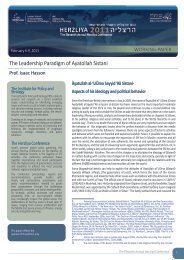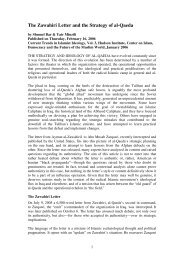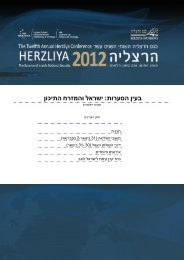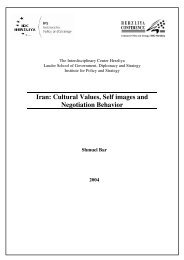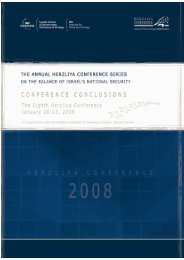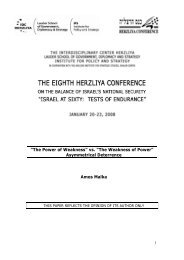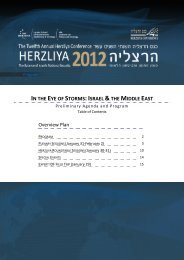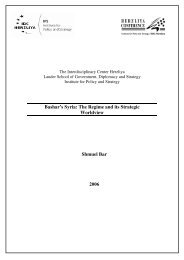Classical Islamic Paradigms of Deterrence and their Expression in ...
Classical Islamic Paradigms of Deterrence and their Expression in ...
Classical Islamic Paradigms of Deterrence and their Expression in ...
You also want an ePaper? Increase the reach of your titles
YUMPU automatically turns print PDFs into web optimized ePapers that Google loves.
argue that us<strong>in</strong>g the term "deterrence" is wrong, but rather "preterrence" 78 should be used for this modusoper<strong>and</strong>i. However, this would be a double-st<strong>and</strong>ard. The actual use <strong>and</strong> not only threat <strong>of</strong> force is also an<strong>in</strong>tegral element <strong>of</strong> Western deterrence (targeted assass<strong>in</strong>ations, house demolitions). Moreover, the actualuse <strong>of</strong> force <strong>in</strong> deterrence accords with endemic perceptions <strong>of</strong> tribal warfare. These perceptions aredeeply rooted underneath the cultural <strong>and</strong> civilization layer <strong>of</strong> every society. The predom<strong>in</strong>ant focus onWMD-deterrence dur<strong>in</strong>g the Cold War has led to the neglect<strong>in</strong>g <strong>of</strong> other forms <strong>of</strong> deterrence for the betterpart <strong>of</strong> half a century. If state actors <strong>and</strong> sub-state actors like salafi-jihadis battle each other, the latter<strong>of</strong>ten refer to asymmetric warfare tactics such as suicide attacks, which they <strong>in</strong>tegrate <strong>in</strong>to extendeddeterrence concepts ("Do not attack us or other Muslims, otherwise we will perpetrate [irrationally look<strong>in</strong>g]martyrdom operations" – [which when used as a war tactic underlie clear rationales]) – while the formerrespond <strong>in</strong> k<strong>in</strong>d with targeted assass<strong>in</strong>ations. This is neo-endemic warfare at the high ends <strong>of</strong> technological<strong>and</strong> doctr<strong>in</strong>aire conflict. In psychological terms, the modus oper<strong>and</strong>i "suicide attack" can be compared toan unconventional weapon <strong>in</strong> the h<strong>and</strong>s <strong>of</strong> a weaker actor fac<strong>in</strong>g a stronger actor: Suddenly the weakeractor ga<strong>in</strong>s deterrence force. Analogies between medieval "catapults" <strong>and</strong> weapons <strong>of</strong> mass destructionare another possible use <strong>of</strong> Muslim sub-state actors to legitimize extended deterrence paradigms (seebelow, 1.c). Also <strong>in</strong> this case extended analogical reason<strong>in</strong>g (qiyas) is applied. One should focus aga<strong>in</strong> ondifferent perceptions <strong>of</strong> deterrence <strong>and</strong> applicability <strong>in</strong> Muslim culture <strong>and</strong> jihadi subculture; as well as <strong>in</strong>state culture versus sub-state culture. Do religiously motivated sub-state actors tend to realize threats;would they always follow a strategy <strong>of</strong> preterrence (pre-emptive deterrence), also with WMD? The bigquestion is how they would behave if they possessed non-conventional weapons.The "pledge <strong>of</strong> the tree" (bay'at al-shajara) is another example <strong>of</strong> a deterrence-st<strong>and</strong><strong>of</strong>f between Muslims<strong>and</strong> non-Muslims. 79 As for the background, <strong>in</strong> March 628 CE, Muhammad went with more than 1000Muslims to Mecca <strong>in</strong> order to perform the annual pilgrimage. 80 However, the Quraysh <strong>of</strong> Mecca denied theMuslims entry to the city. Therefore, Muhammad sent an envoy, 'Uthman b<strong>in</strong> 'Affan, to negotiateunh<strong>in</strong>dered entry <strong>in</strong>to the city. When the envoy Uthman did not return, the Muslims assumed that he hadbeen killed or taken prisoner. Muhammad assembled his followers under a tree <strong>and</strong> took a pledge <strong>of</strong>allegiance to fight for Uthman ("kanat bay'atun fi 'Uthman"), who was later released by the Quraysh.Muhammad’s followers pledged "not to run away" (baya'nahu ann la nafirra). Some traditions stress that"we did not pledge loyalty until death." Other traditions, which are more <strong>in</strong> l<strong>in</strong>e with jihadi doctr<strong>in</strong>e,narrate that Muhammad dem<strong>and</strong>ed a pledge <strong>of</strong> loyalty "until death" ('ala al-maut). 81Both sides used threat display. The Quraysh levered deterrence by denial (block<strong>in</strong>g entrance to <strong>their</strong> city)aga<strong>in</strong>st the Muslims, who responded with threaten<strong>in</strong>g deterrence by punishment to <strong>in</strong>fluence <strong>their</strong>adversaries’ behavior (pledg<strong>in</strong>g, s<strong>in</strong>g<strong>in</strong>g, show <strong>of</strong> force <strong>and</strong> determ<strong>in</strong>ation). Such st<strong>and</strong><strong>of</strong>fs were frequent<strong>and</strong> <strong>in</strong>tegral elements <strong>of</strong> endemic warfare <strong>of</strong> 7 th century tribal society on the Arabian Pen<strong>in</strong>sula. At leastonce a year, a truce was concluded to end the constant state <strong>of</strong> low scale conflict <strong>and</strong> allow pilgrims toenter Mecca. It is utterly important to underst<strong>and</strong><strong>in</strong>g the deeper social dynamics connected to the pledge78 This concept stems from Shmuel Bar.79 Also called "pledge <strong>of</strong> the pleasure [<strong>of</strong> Allah] (bay'at al-ridwan). The Qur'an quote reads like a description <strong>of</strong> a rite <strong>of</strong> personal devotionthat was performed for the sake <strong>of</strong> the community. Certa<strong>in</strong>ly Allah was well pleased with the believers when they swore allegiance to you[idh yubayi'unaka] under the tree, <strong>and</strong> He knew what was <strong>in</strong> <strong>their</strong> hearts, so He sent down tranquillity on them <strong>and</strong> rewarded them with anear victory." See Qur'an Surat al-Fath 48:18, translation by Muhammad Habib Shakir, (Accessed Mai 4, 2012) -http://www.muslimaccess.com/quraan/translations/shakir/048.htm.80 Some traditions speak about 1400, others about 1300 followers who accompanied Muhammad to Mecca <strong>in</strong> 628 CE.81 "Tarikh Dimashq li ibn Asakir,"No. 15194, (Accessed May 5, 201) -http://www.islamweb.net/hadith/display_hbook.php?bk_no=798&hid=15194&pid=609094Another tradition states that the second sub-pledge was to loyalty until death. Musnad Ahmad ibn Hanbal, No. 16206, (Accessed May 5,2012) - http://www.islamweb.net/hadith/display_hbook.php?bk_no=121&hid=16206&pid=67265025



